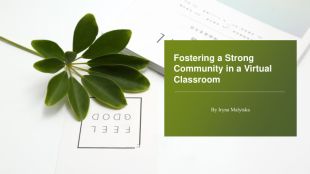Fostering a Strong Community in a Virtual Classroom
Про матеріал
Fostering a Strong Community in a Virtual Classroom
Презинтація. Навчання офлайн Перегляд файлу
Зміст слайдів


Безкоштовний сертифікат
про публікацію авторської розробки
про публікацію авторської розробки
Щоб отримати, додайте розробку
Додати розробку


















